
The Samuel Colby House is a historic house located at 74 Winthrop Street in Taunton, Massachusetts. Built in 1869 for a prominent local businessman, it is one of the city's best examples of high-style Italianate architecture. It was listed on the National Register of Historic Places in 1984.

The Onslow Gilmore House is a historic house at 477 Main Street in Stoneham, Massachusetts. Built about 1875, it is one of the few surviving Italianate houses of many that once lined Main Street south of Central Square. It was listed on the National Register of Historic Places in 1984. It now houses professional offices.

The James and Mary Forsyth House is located on Albany Avenue near uptown Kingston, New York, United States. It is a brick Italian villa-style house designed by Richard Upjohn in the mid-19th century. When it was finished it was celebrated locally for its lavish decor. James Forsyth, as well as another later resident, left the house after being accused of financial wrongdoing. It has been modified slightly since its original construction with trim in the Colonial Revival style.

The Walter Merchant House, on Washington Avenue in Albany, New York, United States, is a brick-and-stone townhouse in the Italianate architectural style, with some Renaissance Revival elements. Built in the mid-19th century, it was listed on the National Register of Historic Places in 2002.

Clifton is a historic building located in the West End of Davenport, Iowa, United States. The residence was individually listed on the National Register of Historic Places in 1979. It was included as a contributing property in the Riverview Terrace Historic District in 1983.

The Thomas Murray House is a historic building located on the east side of Davenport, Iowa, United States. It has been listed on the National Register of Historic Places since 1984.
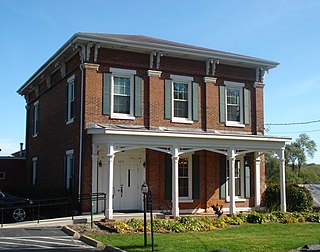
The Dawley House is an historic property located in Le Claire, Iowa, United States, and has been listed on the National Register of Historic Places since 1979. It is the former home of Daniel V. Dawley. The property is part of the Houses of Mississippi River Men Thematic Resource, which covers the homes of men from Le Claire who worked on the Mississippi River as riverboat captains, pilots, builders and owners.

The Lathrop Russell Charter House is a historic home located at West Union, Doddridge County, West Virginia, U.S.A. It was built in 1877, and is a two-story, T-shaped frame dwelling, with a low-pitched hipped roof with bracketed eaves. It features tall crowned windows and a two-story side porch. Also on the property is a contributing guest house.

The William H. Hull House is a historic house located at 1517 Walnut St. in Murphysboro, Illinois. The house was built in 1887 for William H. Hull, a significant local businessman and politician. The house is designed in an asymmetrical Italianate pattern. The front facade of the house features a three-sided projecting bay topped by a half-hipped roof. The main entrance is located to the side of the bay in a porch supported by chamfered columns with decorative brackets. The cornice of the house features a patterned molding divided by ornamental brackets. The house's roof has a cross-hipped design with flared eaves.
The Elkinton-Butcher House is a 2 1⁄2-story, double-pile, side-passage, federal style brick dwelling located in Mauricetown, New Jersey in Cumberland County.
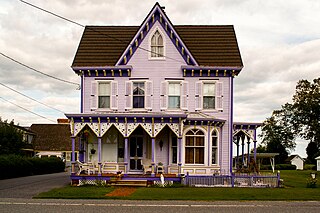
The Sharp-Mickle House is a Gothic Revival style dwelling located in Mauricetown, New Jersey, constructed around 1860 by landowner and farmer Seth Sharp. The building today resembles its appearance after its 1879 remodel by Samuel Mickle. This building is a private residence and not open to the public.
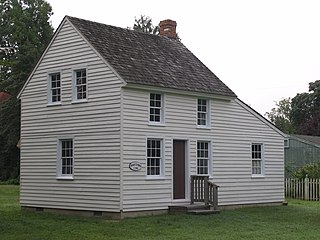
The Abraham and Ann Hoy House is a vernacular building, located in Mauricetown, Cumberland County, New Jersey, constructed around 1860. It is owned by the Mauricetown Historical Society.
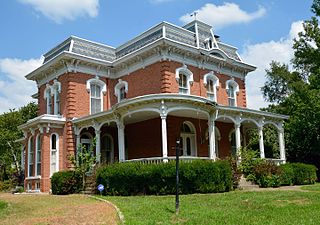
The Samuel Moody Grubbs House is a historic house located at 805 E. Union Ave. in Litchfield, Illinois. The house was built in 1873-74 for Samuel Moody Grubbs, a banker who later became Litchfield's mayor. George Ingham Barnett, a prominent St. Louis architect, designed the Second Empire house; it is the only standing Barnett design in Illinois. The design is typical of the second half of Barnett's career, when he shifted from Italianate to Second Empire designs, and represents a popular style in postbellum America. A mansard roof with slate tiles tops the house; a cornice running along the roofline features paired brackets. The front of the house features a wraparound porch supported by columns. The house's corners have bold quoins. In a deviation from the typical rectangular plans of Second Empire houses, Barnett gave the house a cross axis plan with projecting wings.
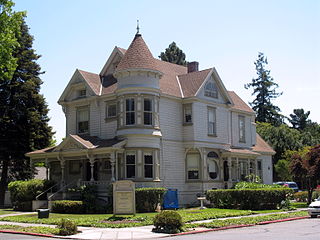
The T. B. Downing House is a historic house located at 706 Cowper St. in Palo Alto, California. The Queen Anne style house was built in 1894 for T. B. Downing, who served on Palo Alto's first city council. A conical tower tops the house's northern corner; the tower features a finial, a dentillated and bracketed cornice, and decorative shinglework. The porch features a decorated gable and gingerbread-style ornamentation along the roof, columns, and balustrade. Two other gables, one at the second floor and one at the attic, adorn the front of the house; both gables feature decorative bargeboards.

Nappanee Eastside Historic District is a national historic district located at Nappanee, Elkhart County, Indiana. The district encompasses 138 contributing buildings in a predominantly residential section of Nappanee. It was developed between about 1880 and 1940, and includes notable examples of Italianate, Queen Anne, Colonial Revival, and Prairie School style architecture. Located in the district are the separately listed Frank and Katharine Coppes House and Arthur Miller House.
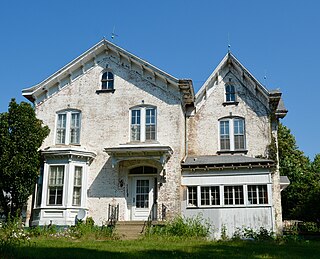
The Edward Hamer House is a historic house located at 200 West 2nd Street in Vermont, Illinois. Businessman Edward Hamer had the house built for himself and his wife in 1871. The house has an Italianate design and is one of two Italianate homes in Vermont with a front-facing gable. Both of the house's gables are steep and feature decorative brackets along the cornice. The front entrance is topped by a decorative hood with braces and paired brackets. A three-sided bay window with matching brackets projects from the first floor next to the entrance; the house's remaining windows are tall, narrow, and topped by segmental arches.
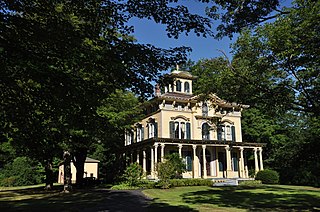
The Philip Chapin House is a historic house at 55 Church Street in the Pine Meadow village of New Hartford, Connecticut. Built in 1867 for a local factory owner, it is an elaborate example of Italianate architecture. It was listed on the National Register of Historic Places in 1977.
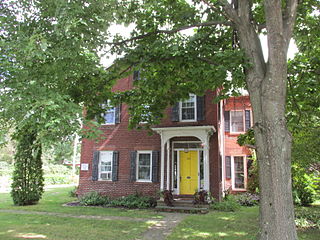
The Sophia Sweetland House is a historic house at 458 Palisado Avenue in Windsor, Connecticut. Built about 1845, it is a good local example of transitional Greek Revival-Italianate architecture executed in brick. It was listed on the National Register of Historic Places in 1988.


























